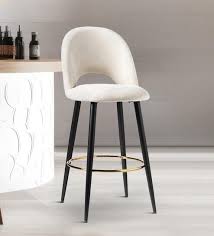1. Purpose and Height:
- Bar stools are designed for seating at bar-height counters, tables, or high-top surfaces.
- Standard height range: 28 to 32 inches, suitable for surfaces that are approximately 40 to 42 inches high.
- Ideal for use in kitchens, home bars, cafes, restaurants, or any space with elevated surfaces.
2. Design Variations:
- Backless Bar Stools: Minimalist design, perfect for modern or compact spaces. Offers flexibility and easy storage.
- Backed Bar Stools: Provide added comfort and support, ideal for longer seating durations or more formal settings.
- Swivel Bar Stools: Feature a rotating seat, allowing users to easily turn and engage with different areas without moving the stool.
- Adjustable Height Bar Stools: Come with a pneumatic lift mechanism, enabling users to adjust the seat height to suit different bar or counter heights.
3. Materials and Construction:
- Wooden Bar Stools: Classic, traditional look, often featuring solid wood frames with a rustic or natural finish. Great for a farmhouse or vintage aesthetic.
- Metal Bar Stools: Sleek and modern, often made from stainless steel, aluminum, or iron. Durable and low maintenance, with a more industrial or contemporary feel.
- Upholstered Bar Stools: Often padded for comfort, with fabric, faux leather, or real leather seats. Ideal for adding a touch of luxury and comfort.
- Plastic or Acrylic Bar Stools: Lightweight, durable, and easy to clean, these stools are often available in bold colors for modern, casual environments.
4. Features for Comfort:
- Footrest: Many bar stools include a footrest bar, providing added comfort by offering a place to rest your feet during extended sitting.
- Cushioned Seats: Some stools are padded or upholstered for greater comfort, especially for longer sitting periods. The upholstery material can range from fabric to leather.
- Backrest: Bar stools with backrests offer additional lumbar support, making them more comfortable for extended use.
5. Styles and Aesthetics:
- Bar stools come in various styles, from sleek and modern to traditional and rustic.
- Materials like wood, metal, and upholstery can be customized to suit any décor style, whether contemporary, industrial, mid-century modern, or farmhouse.
- Some bar stools feature decorative elements like decorative backrests, intricate metalwork, or contrasting materials (e.g., wooden seat with metal legs).
6. Space-Saving and Flexibility:
- Bar stools are typically compact and lightweight, making them easy to move around or store when not in use.
- Swivel stools and backless models are especially space-efficient, allowing stools to be tucked away under counters or tables.
7. Versatility of Use:
- Home Bars & Kitchens: Bar stools are commonly used at home bars, kitchen islands, breakfast bars, or high-top dining tables, enhancing both functionality and style.
- Commercial Spaces: Frequently found in cafes, restaurants, hotels, and bars, bar stools can cater to both casual and formal seating arrangements.
- Outdoor Spaces: Some bar stools are made from weather-resistant materials, making them suitable for outdoor use, such as around a patio bar or outdoor kitchen.
8. Durability and Maintenance:
- Wooden Bar Stools: Durable but may require occasional maintenance to preserve the wood finish.
- Metal Bar Stools: Often highly durable, easy to clean, and resistant to wear and tear.
- Upholstered Bar Stools: Fabric or leather options may require regular cleaning, but they provide superior comfort and luxury.
9. Advantages:
- Comfortable and Functional: Bar stools are designed for longer sitting, providing support and comfort for tasks like eating, socializing, or working.
- Stylish Addition to Space: Bar stools add a touch of style and sophistication to a kitchen, bar, or dining area, often becoming a focal point in the room.
- Versatile and Practical: Bar stools work well in various settings, whether in a busy kitchen, modern home bar, or professional restaurant setting.





Reviews
There are no reviews yet.